MITSUBISHI MIRAGE G4 2020 (in English) Workshop Manual
Manufacturer: MITSUBISHI, Model Year: 2020, Model line: MIRAGE G4, Model: MITSUBISHI MIRAGE G4 2020Pages: 253, PDF Size: 36.39 MB
Page 51 of 253
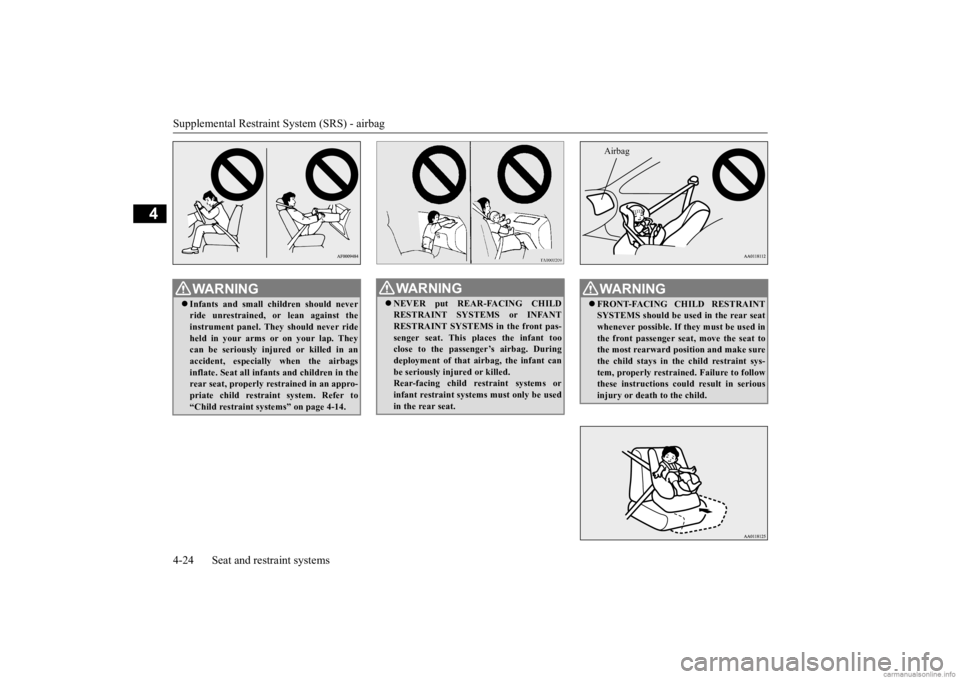
Supplemental Restraint System (SRS) - airbag 4-24 Seat and restraint systems
4
WA R N I N G Infants and small children should never ride unrestrained,
or lean against the
instrument panel. They should never ride held in your arms or
on your lap. They
can be seriously inju
red or killed in an
accident, especially when the airbags inflate. Seat all infa
nts and children in the
rear seat, properly re
strained in an appro-
priate child restraint system. Refer to “Child restraint systems” on page 4-14.
WA R N I N G NEVER put REAR-FACING CHILD RESTRAINT SYSTEMS or INFANT RESTRAINT SYSTEMS in the front pas- senger seat. This pl
aces the infant too
close to the passenger’s airbag. During deployment of that airbag, the infant can be seriously inju
red or killed.
Rear-facing child restraint systems or infant restraint systems must only be used in the rear seat.
WA R N I N G FRONT-FACING CHILD RESTRAINT SYSTEMS should be used in the rear seatwhenever possible. If they must be used in the front passenger se
at, move the seat to
the most rearward po
sition and make sure
the child stays in the child restraint sys- tem, properly restrained. Failure to follow these instructions could result in seriousinjury or death to the child.Airbag
BK0284300US.book 24 ページ 2019年5月23日 木曜日 午後12時22分
Page 52 of 253
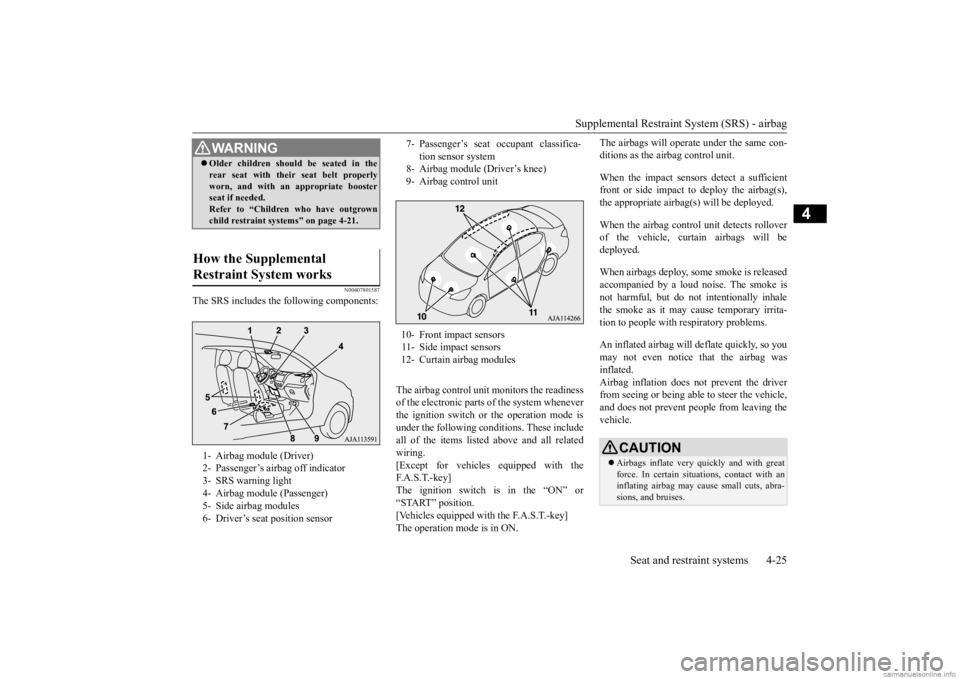
Supplemental Restraint System (SRS) - airbag
Seat and restraint systems 4-25
4
N00407801587
The SRS includes the following components:
The airbag control unit
monitors the readiness
of the electronic parts of the system whenever the ignition switch or the operation mode is under the following conditions. These includeall of the item
s listed above a
nd all related
wiring. [Except for vehicles equipped with theF.A.S.T.-key] The ignition switch is in the “ON” or “START” position.[Vehicles equipped with the F.A.S.T.-key] The operation mode is in ON.
The airbags will operate under the same con- ditions as the airbag control unit. When the impact sensors detect a sufficient front or side impact to deploy the airbag(s), the appropriate airbag
(s) will be deployed.
When the airbag control unit detects rollover of the vehicle, curtain airbags will bedeployed. When airbags deploy, some smoke is released accompanied by a loud noise. The smoke is not harmful, but do not
intentionally inhale
the smoke as it may ca
use temporary irrita-
tion to people with respiratory problems. An inflated airbag will
deflate quickly, so you
may not even notice that the airbag was inflated. Airbag inflation does not prevent the driverfrom seeing or being able
to steer the vehicle,
and does not prevent people from leaving the vehicle.
WA R N I N G Older children should be seated in the rear seat with their seat belt properlyworn, and with an
appropriate booster
seat if needed. Refer to “Children
who have outgrown
child restraint syst
ems” on page 4-21.
How the Supplemental Restraint System works 1- Airbag module (Driver) 2- Passenger’s airb
ag off indicator
3- SRS warning light 4- Airbag module (Passenger)5- Side airbag modules 6- Driver’s seat position sensor
7- Passenger’s seat oc
cupant classifica-
tion sensor system
8- Airbag module (Driver’s knee)9- Airbag control unit 10- Front impact sensors 11- Side impact sensors12- Curtain airbag modules
CAUTION Airbags inflate very quickly and with great force. In certain situations, contact with an inflating airbag may cause small cuts, abra-sions, and bruises.
BK0284300US.book 25 ページ 2019年5月23日 木曜日 午後12時22分
Page 53 of 253
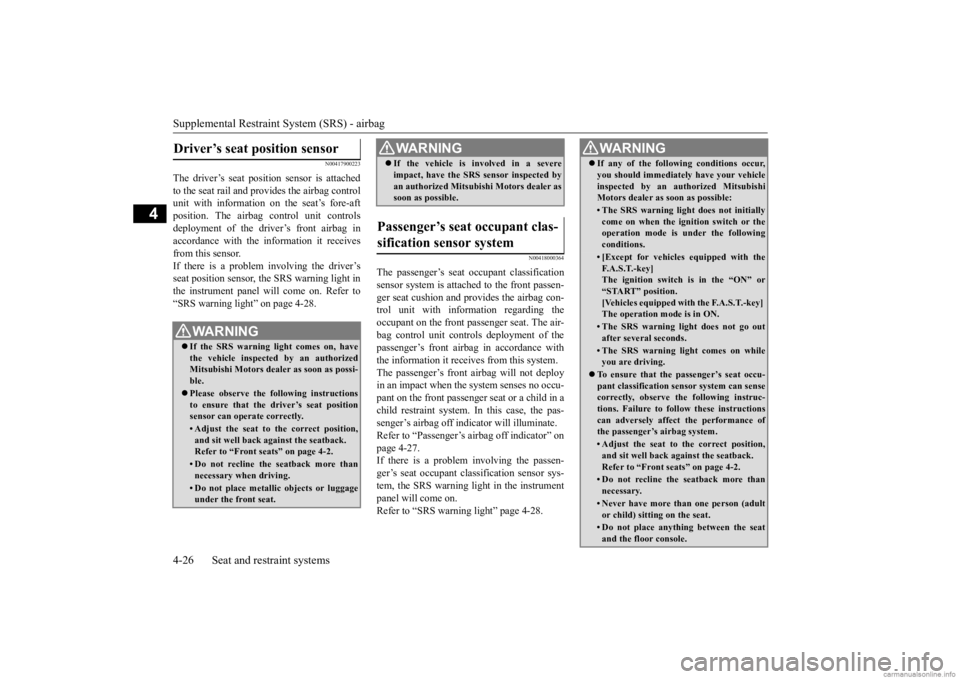
Supplemental Restraint System (SRS) - airbag 4-26 Seat and restraint systems
4
N00417900223
The driver’s seat position sensor is attached to the seat rail and provides the airbag control unit with information on the seat’s fore-aftposition. The airbag control unit controls deployment of the driver’s front airbag in accordance with the information it receivesfrom this sensor. If there is a problem involving the driver’s seat position sensor, the SRS warning light in the instrument panel will come on. Refer to “SRS warning light” on page 4-28.
N00418000364
The passenger’s seat oc
cupant classification
sensor system is attach
ed to the front passen-
ger seat cushion and provides the airbag con- trol unit with information regarding theoccupant on the front passenger seat. The air- bag control unit controls deployment of the passenger’s front airbag in accordance withthe information it receives from this system. The passenger’s front ai
rbag will not deploy
in an impact when the system senses no occu-pant on the front passenger seat or a child in a child restraint system. In this case, the pas- senger’s airbag off indi
cator will illuminate.
Refer to “Passenger’s ai
rbag off indicator” on
page 4-27. If there is a problem involving the passen-ger’s seat occupant cl
assification sensor sys-
tem, the SRS warning light in the instrument panel will come on.Refer to “SRS warning light” page 4-28.
Driver’s seat position sensor
WA R N I N G If the SRS warning
light comes on, have
the vehicle inspecte
d by an authorized
Mitsubishi Motors dealer as soon as possi-ble. Please observe the following instructions to ensure that the driver’s seat position sensor can operate correctly.• Adjust the seat to the correct position,and sit well back
against the seatback.
Refer to “Front seats” on page 4-2.• Do not recline the seatback more thannecessary when driving.• Do not place metall
ic objects or luggage
under the front seat.
If the vehicle is involved in a severe impact, have the SRS sensor inspected byan authorized
Mitsubishi Motors dealer as
soon as possible.
Passenger’s seat occupant clas- sification sensor system
WA R N I N G
WA R N I N G If any of the follow
ing conditions occur,
you should immediatel
y have your vehicle
inspected by an au
thorized Mitsubishi
Motors dealer as soon as possible:• The SRS warning light does not initiallycome on when the ignition switch or the operation mode is under the following conditions.• [Except for vehicles equipped with theF. A . S . T. - k e y ]The ignition switch is in the “ON” or “START” position. [Vehicles equipped with the F.A.S.T.-key] The operation mode is in ON.• The SRS warning light does not go outafter several seconds.• The SRS warning li
ght comes on while
you are driving.
To ensure that the passenger’s seat occu- pant classification sensor system can sense correctly, observe the following instruc- tions. Failure to follow these instructionscan adversely affect
the performance of
the passenger’s airbag system.• Adjust the seat to the correct position,and sit well back
against the seatback.
Refer to “Front seats” on page 4-2.• Do not recline the seatback more thannecessary.• Never have more than one person (adultor child) sitting
on the seat.
• Do not place anything between the seat and the floor console.
BK0284300US.book 26 ページ 2019年5月23日 木曜日 午後12時22分
Page 54 of 253
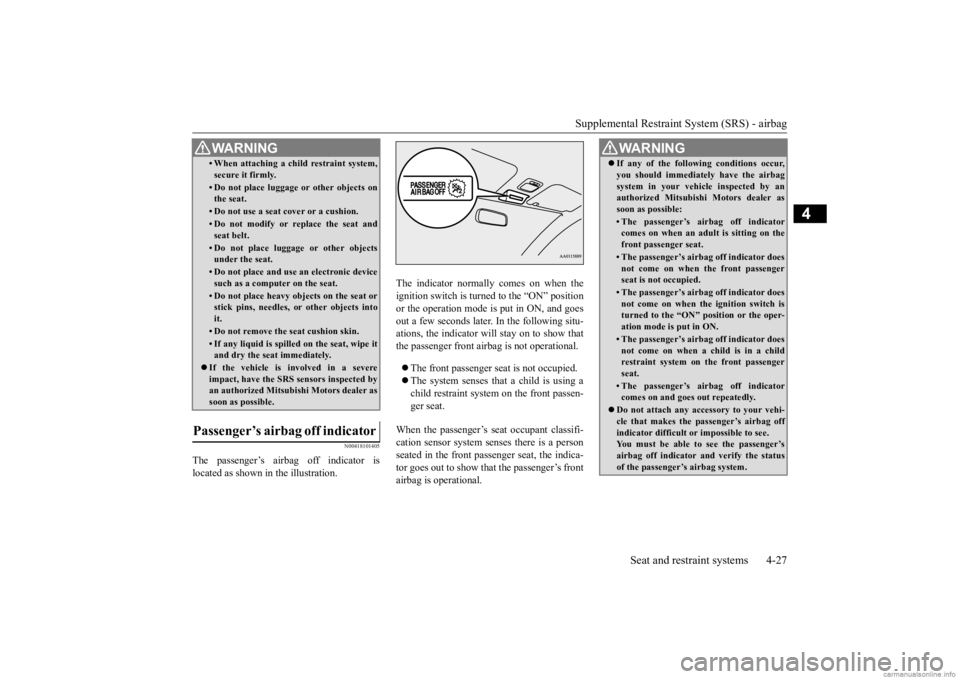
Supplemental Restraint System (SRS) - airbag
Seat and restraint systems 4-27
4
N00418101405
The passenger’s airbag off indicator is located as shown in
the illustration.
The indicator normally comes on when the ignition switch is turned to the “ON” positionor the operation mode is put in ON, and goes out a few seconds later.
In the following situ-
ations, the indicator will stay on to show thatthe passenger front airb
ag is not operational.
The front passenger se
at is not occupied.
The system senses that a child is using a child restraint system on the front passen-ger seat.
When the passenger’s seat occupant classifi- cation sensor system se
nses there is a person
seated in the front pa
ssenger seat, the indica-
tor goes out to show that the passenger’s front airbag is operational.
• When attaching a child restraint system, secure it firmly.• Do not place luggage or other objects on the seat.• Do not use a seat cover or a cushion.• Do not modify or re
place the seat and
seat belt.• Do not place luggage or other objectsunder the seat.• Do not place and use
an electronic device
such as a computer on the seat.• Do not place heavy obje
cts on the seat or
stick pins, needles, or other objects into it.• Do not remove the seat cushion skin.• If any liquid is spilled on the seat, wipe it and dry the seat immediately.
If the vehicle is involved in a severe impact, have the SRS sensors inspected by an authorized
Mitsubishi Motors dealer as
soon as possible.
Passenger’s airbag off indicator
WA R N I N G
WA R N I N G If any of the following conditions occur, you should immediat
ely have the airbag
system in your vehicle inspected by anauthorized Mitsubishi
Motors dealer as
soon as possible:• The passenger’s airbag off indicatorcomes on when an adul
t is sitting on the
front passenger seat.• The passenger’s airbag off indicator doesnot come on when the front passengerseat is not occupied.• The passenger’s airbag off indicator doesnot come on when the ignition switch is turned to the “ON” position or the oper- ation mode is put in ON.• The passenger’s airbag off indicator doesnot come on when a
child is in a child
restraint system on the front passenger seat.• The passenger’s airbag off indicatorcomes on and goes out repeatedly.
Do not attach any ac
cessory to your vehi-
cle that makes the passenger’s airbag off indicator difficult or impossible to see.You must be able to see the passenger’s airbag off indicator and verify the status of the passenger’s airbag system.
BK0284300US.book 27 ページ 2019年5月23日 木曜日 午後12時22分
Page 55 of 253
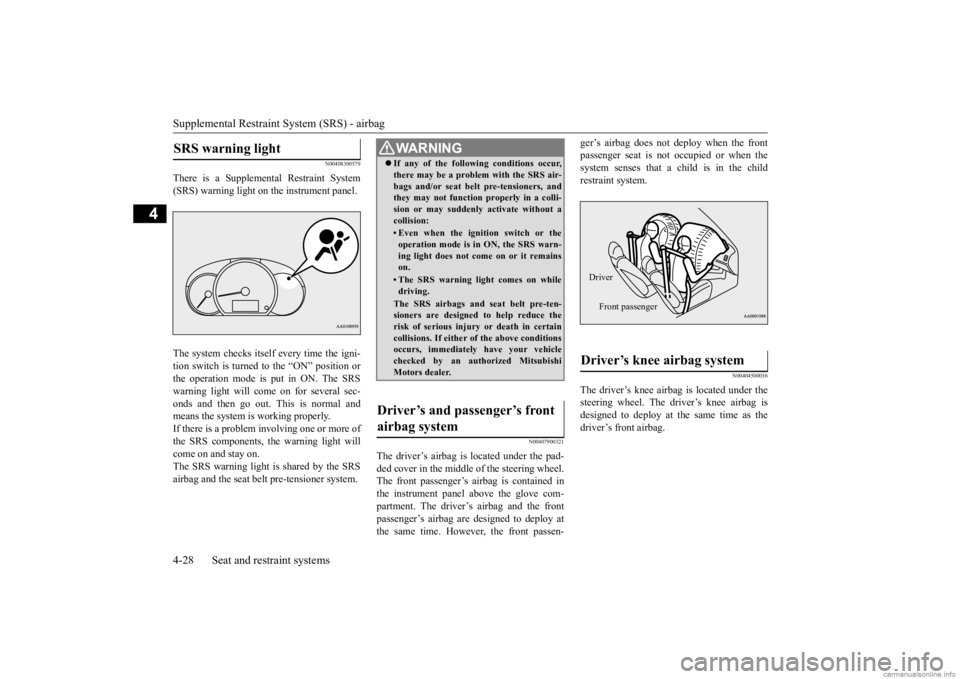
Supplemental Restraint System (SRS) - airbag 4-28 Seat and restraint systems
4
N00408300579
There is a Supplemen
tal Restraint System
(SRS) warning light on the instrument panel. The system checks itself every time the igni- tion switch is turned to the “ON” position orthe operation mode is put in ON. The SRS warning light will come on for several sec- onds and then go out. This is normal andmeans the system is working properly. If there is a problem involving one or more of the SRS components, the warning light willcome on and stay on. The SRS warning light is shared by the SRS airbag and the seat belt
pre-tensioner system.
N00407900321
The driver’s airbag is located under the pad- ded cover in the middle of the steering wheel. The front passenger’s airbag is contained inthe instrument panel above the glove com- partment. The driver’s airbag and the front passenger’s airbag ar
e designed to deploy at
the same time. However, the front passen-
ger’s airbag does not deploy when the front passenger seat is not occupied or when thesystem senses that a child is in the child restraint system.
N00404500036
The driver’s knee airbag is located under the steering wheel. The driver’s knee airbag is designed to deploy at
the same time as the
driver’s front airbag.
SRS warning light
WA R N I N G If any of the following conditions occur, there may be a proble
m with the SRS air-
bags and/or seat belt pre-tensioners, andthey may not function
properly in a colli-
sion or may suddenly
activate without a
collision:•Even when the igniti
on switch or the
operation mode is in ON, the SRS warn-ing light does not come on or it remains on.• The SRS warning li
ght comes on while
driving.The SRS airbags and
seat belt pre-ten-
sioners are designed to help reduce the risk of serious injury
or death in certain
collisions. If either of the above conditions occurs, immediately
have your vehicle
checked by an auth
orized Mitsubishi
Motors dealer.
Driver’s and passenger’s front airbag system
Driver’s knee airbag system Driver Front passenger
BK0284300US.book 28 ページ 2019年5月23日 木曜日 午後12時22分
Page 56 of 253
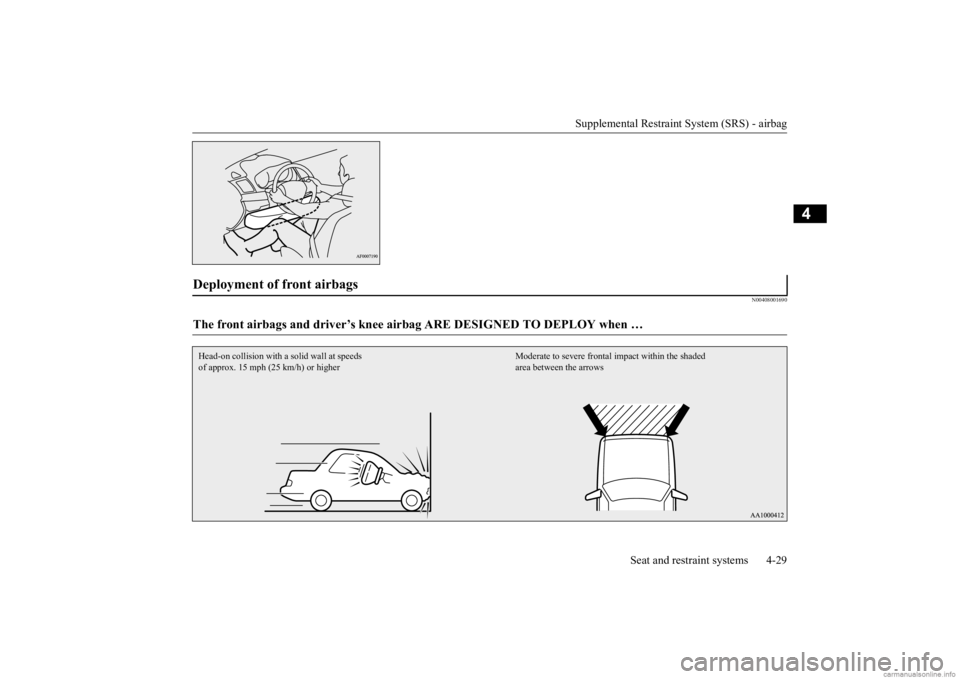
Supplemental Restraint System (SRS) - airbag
Seat and restraint systems 4-29
4
N00408001690
Deployment of front airbags The front airbags and driver’s knee airb
ag ARE DESIGNED TO DEPLOY when …
Head-on collision with a solid wall at speeds of approx. 15 mph (25 km/h) or higher
Moderate to severe frontal
impact within the shaded
area between the arrows
BK0284300US.book 29 ページ 2019年5月23日 木曜日 午後12時22分
Page 57 of 253
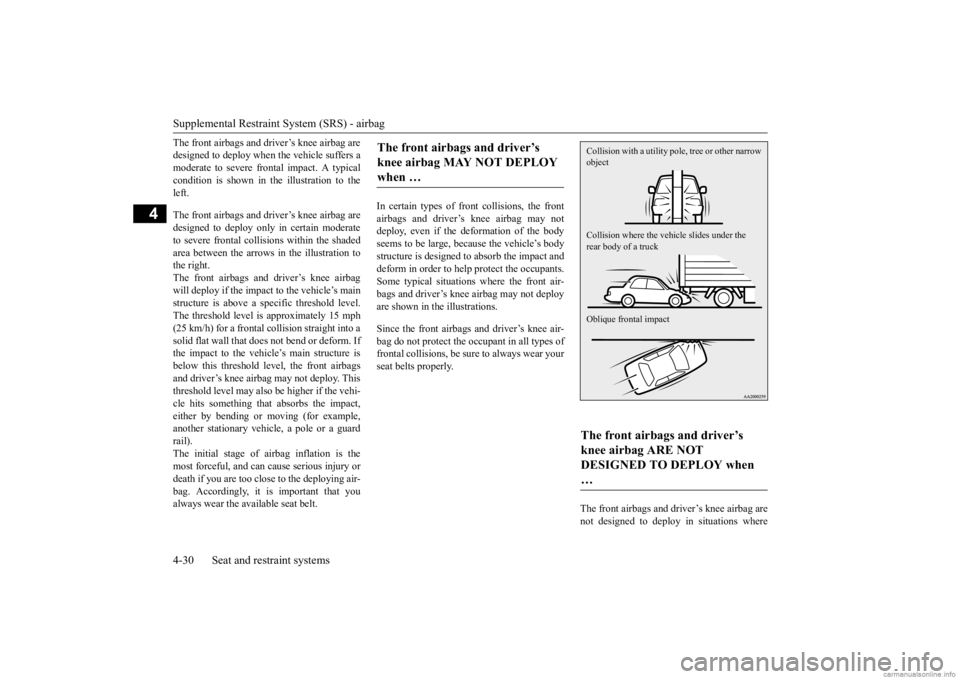
Supplemental Restraint System (SRS) - airbag 4-30 Seat and restraint systems
4
The front airbags and driver’s knee airbag are designed to deploy when the vehicle suffers amoderate to severe fr
ontal impact. A typical
condition is shown in the illustration to the left. The front airbags and driver’s knee airbag are designed to deploy only in certain moderate to severe frontal collisions within the shaded area between the arrows in the illustration tothe right. The front airbags and driver’s knee airbag will deploy if the impact to the vehicle’s main structure is above a sp
ecific threshold level.
The threshold level is
approximately 15 mph
(25 km/h) for a frontal collision straight into a solid flat wall that does not bend or deform. If the impact to the vehicle’s main structure isbelow this threshold level, the front airbags and driver’s knee airbag may not deploy. This threshold level may also
be higher if the vehi-
cle hits something that absorbs the impact, either by bending or moving (for example, another stationary vehi
cle, a pole or a guard
rail). The initial stage of airbag inflation is the most forceful, and can cause serious injury ordeath if you are too close to the deploying air- bag. Accordingly, it
is important that you
always wear the available seat belt.
In certain types of front collisions, the front airbags and driver’s knee airbag may notdeploy, even if the deformation of the body seems to be large, because the vehicle’s body structure is designed to absorb the impact anddeform in order to help
protect the occupants.
Some typical situations where the front air- bags and driver’s knee airbag may not deploy are shown in the illustrations. Since the front airbags and driver’s knee air- bag do not protect the oc
cupant in all types of
frontal collisions, be su
re to always wear your
seat belts properly.
The front airbags and driver’s knee airbag are not designed to deploy in situations where
The front airbags and driver’s knee airbag MAY NOT DEPLOY when …
The front airbags and driver’s knee airbag ARE NOT DESIGNED TO DEPLOY when … Collision with a utility pole
, tree or other narrow
object Collision where the vehi
cle slides under the
rear body of a truck Oblique frontal impact
BK0284300US.book 30 ページ 2019年5月23日 木曜日 午後12時22分
Page 58 of 253
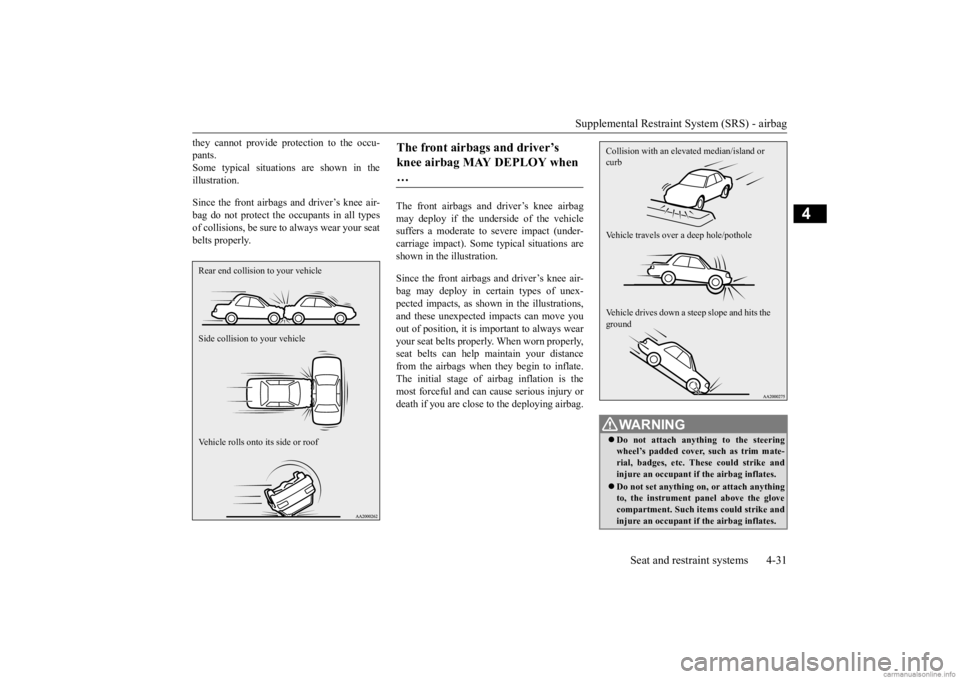
Supplemental Restraint System (SRS) - airbag
Seat and restraint systems 4-31
4
they cannot provide protection to the occu- pants.Some typical situations are shown in the illustration. Since the front airbags and driver’s knee air- bag do not protect the oc
cupants in all types
of collisions, be sure
to always wear your seat
belts properly.
The front airbags and driver’s knee airbag may deploy if the underside of the vehiclesuffers a moderate to
severe impact (under-
carriage impact). Some
typical situations are
shown in the illustration. Since the front airbags and driver’s knee air- bag may deploy in certain types of unex- pected impacts, as show
n in the illustrations,
and these unexpected
impacts can move you
out of position, it is
important to always wear
your seat belts properly.
When worn properly,
seat belts can help maintain your distance from the airbags when they begin to inflate. The initial stage of airbag inflation is themost forceful and can
cause serious injury or
death if you are close to the deploying airbag.
Rear end collision to your vehicle Side collision to your vehicle Vehicle rolls onto its side or roof
The front airbags and driver’s knee airbag MAY DEPLOY when …
WA R N I N G Do not attach anything to the steering wheel’s padded cover, such as trim mate- rial, badges, etc. These could strike andinjure an occupant if
the airbag inflates.
Do not set anything on, or attach anything to, the instrument
panel above the glove
compartment. Such items could strike and injure an occupant if
the airbag inflates.
Collision with an elevat
ed median/island or
curb Vehicle travels over a deep hole/pothole Vehicle drives down a steep slope and hits the ground
BK0284300US.book 31 ページ 2019年5月23日 木曜日 午後12時22分
Page 59 of 253
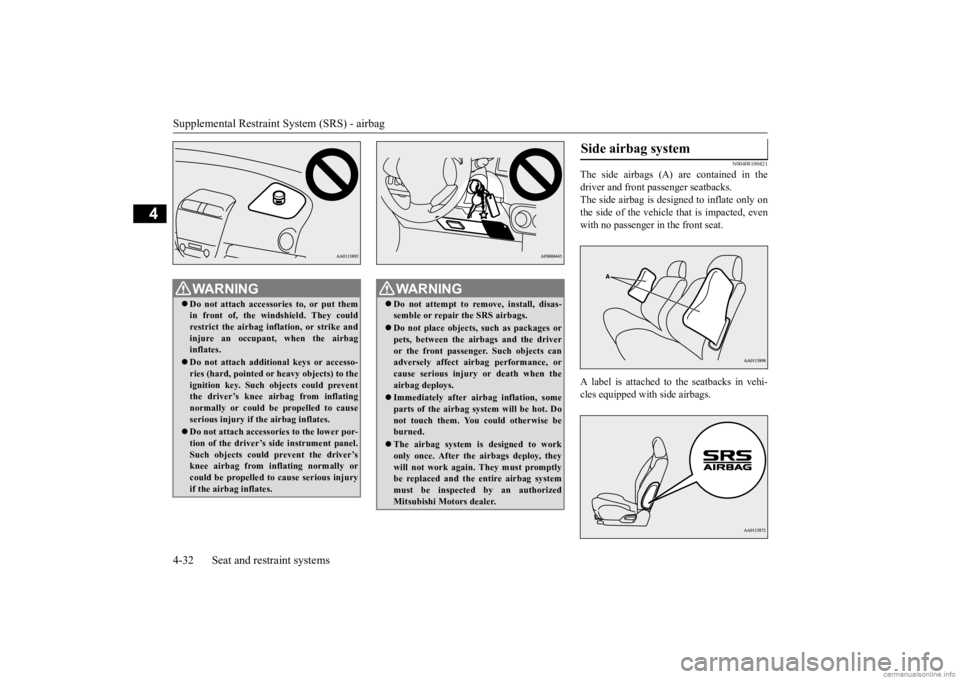
Supplemental Restraint System (SRS) - airbag 4-32 Seat and restraint systems
4
N00408100421
The side airbags (A) are contained in the driver and front passenger seatbacks. The side airbag is de
signed to inflate only on
the side of the vehicle that is impacted, even with no passenger in the front seat. A label is attached to the seatbacks in vehi- cles equipped with side airbags.
WA R N I N G Do not attach accessories to, or put them in front of, the windshield. They couldrestrict the airbag inflation, or strike and injure an occupant
, when the airbag
inflates. Do not attach addition
al keys or accesso-
ries (hard, pointed or
heavy objects) to the
ignition key. Such objects could prevent the driver’s knee ai
rbag from inflating
normally or could be propelled to causeserious injury if
the airbag inflates.
Do not attach accessories to the lower por- tion of the driver’s side instrument panel. Such objects could prevent the driver’s knee airbag from inflating normally orcould be propelled to cause serious injury if the airbag inflates.
WA R N I N G Do not attempt to remove, install, disas- semble or repair the SRS airbags. Do not place objects,
such as packages or
pets, between the airbags and the driveror the front passenger. Such objects can adversely affect ai
rbag performance, or
cause serious injury or death when theairbag deploys. Immediately after airbag inflation, some parts of the airbag syst
em will be hot. Do
not touch them. You could otherwise be burned. The airbag system is designed to work only once. After the
airbags deploy, they
will not work again. They must promptly be replaced and the
entire airbag system
must be inspected by an authorizedMitsubishi Motors dealer.
Side airbag system
BK0284300US.book 32 ページ 2019年5月23日 木曜日 午後12時22分
Page 60 of 253
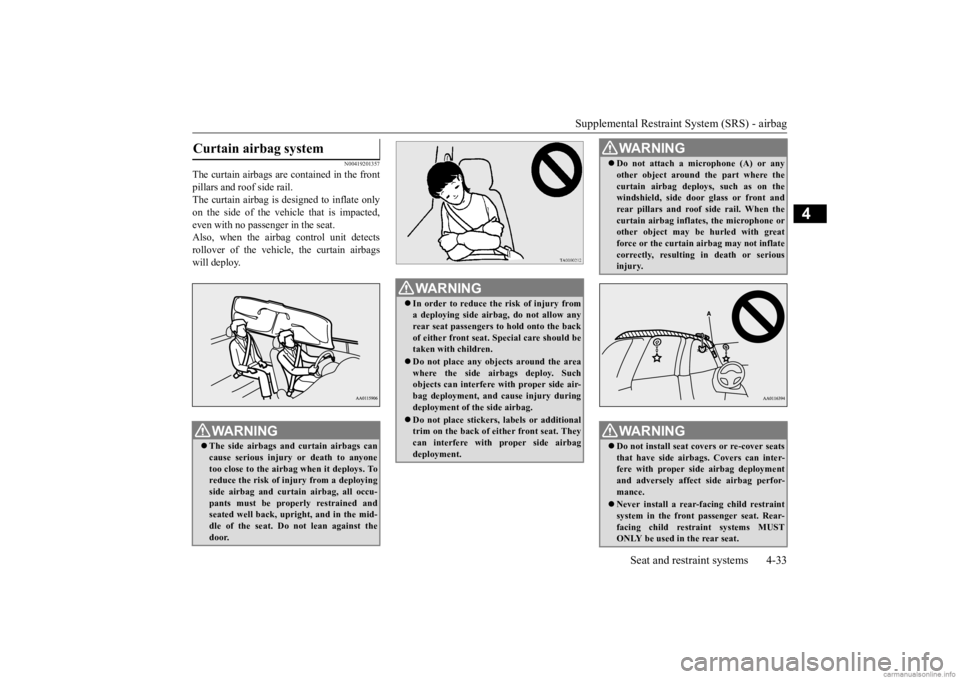
Supplemental Restraint System (SRS) - airbag
Seat and restraint systems 4-33
4
N00419201357
The curtain airbags are contained in the front pillars and roof side rail. The curtain airbag is designed to inflate onlyon the side of the ve
hicle that is impacted,
even with no passenger in the seat. Also, when the airbag control unit detectsrollover of the vehicle, the curtain airbags will deploy.Curtain airbag system
WA R N I N G The side airbags and curtain airbags can cause serious injury
or death to anyone
too close to the airbag when it deploys. To reduce the risk of in
jury from a deploying
side airbag and curtai
n airbag, all occu-
pants must be properly restrained and seated well back, upright, and in the mid- dle of the seat. Do
not lean against the
door.
WA R N I N G In order to reduce the risk of injury from a deploying side airb
ag, do not allow any
rear seat passengers to hold onto the back of either front seat. Special care should betaken with children. Do not place any obje
cts around the area
where the side airbags deploy. Such objects can interfere with proper side air- bag deployment, and cause injury duringdeployment of the side airbag. Do not place stickers,
labels or additional
trim on the back of either front seat. They can interfere with proper side airbag deployment.
Do not attach a microphone (A) or any other object around the part where thecurtain airbag deploys
, such as on the
windshield, side door glass or front and rear pillars and roof
side rail. When the
curtain airbag inflates
, the microphone or
other object may be
hurled with great
force or the curtain airbag may not inflate correctly, resulting in death or seriousinjury.WA R N I N G Do not install seat c
overs or re-cover seats
that have side airb
ags. Covers can inter-
fere with proper si
de airbag deployment
and adversely affect
side airbag perfor-
mance. Never install a rear-facing child restraint system in the front passenger seat. Rear- facing child restraint systems MUST ONLY be used in the rear seat.WA R N I N G
BK0284300US.book 33 ページ 2019年5月23日 木曜日 午後12時22分